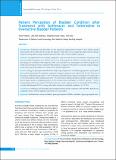Please use this identifier to cite or link to this item:
https://hdl.handle.net/20.500.14356/980| Title: | Patient Perception of Bladder Condition after Treatment with Solifenacin and Tolterodine in Overactive Bladder Patients |
| Authors: | Pradhan, Tarun Dhamala, Jiba Nath Yadav, Siddartha Kumar Deo, Amit |
| Citation: | PradhanT., DhamalaJ. N., YadavS. K., & DeoA. (2023). Patient Perception of Bladder Condition after Treatment with Solifenacin and Tolterodine in Overactive Bladder Patients. Journal of Nepal Health Research Council, 20(3), 750-754. https://doi.org/10.33314/jnhrc.v20i3.4366 |
| Issue Date: | 2022 |
| Publisher: | Nepal Health Research Council |
| Keywords: | Antimuscarinic overactive bladder patient perceptions of bladder condition urgency perception score |
| Series/Report no.: | July-Sep, 2022;4366 |
| Abstract: | Abstract Background: Solefinacin and Tolterodine are new generation antimuscarinics claimed to have bladder specific action and less adverse effect like dry mouth. The objective of the study was to compare the improvement in urinary symptoms among patients using solefinacin and tolterodine with overactive bladder symptoms. Methods: A hospital based cross-sectional comparative study was done for one year duration. All patients with overactive bladder symptoms were included and in every alternate patient’s solefinacin and tolterodine were given after taking note of baseline OAB symptoms, PPBC score and UPS score. Participants were followed up after one month and noted improvement in endpoint OAB symptoms. Comparison of baseline to end-point symptoms changes among each group of participants were analyzed for statistical significance. Results: Among 101 participants included in the study, 49 participants were in solefinacin group and 52 participants were in tolterodine group. The end-point comparison of urgency symptoms were improved by 20.1±6.76 (mean ± SD) units in solefinacin group and by 17.0 ± 9.18 units in tolterodine group. Urgency perception score improved to 2.1±0.66 for patients under solefinacin and 2±0.73 for tolterodine. Patient perception of bladder condition (PPBC) showed improvement in solefinacin group by 3.2±1.26 units and in tolteradine by 2.8±1.54 units (p = 0.165). Comparing the patient’s perception of treatment outcome, massive improvement was reported by 81.6% of those receiving Solefinacinand 65.4% receiving tolterodine, though not statistically significant ( p = 0.131). Conclusions: Solefinacin and Tolterodine showed improvement in urinary symptoms, UPS and PPBC. Both showed comparable efficacy without significant superiority over one another. Keywords: Antimuscarinic; overactive bladder; patient perceptions of bladder condition; urgency perception score. |
| Description: | Original Article |
| URI: | http://103.69.126.140:8080/handle/20.500.14356/980 |
| ISSN: | Print ISSN: 1727-5482; Online ISSN: 1999-6217 |
| Appears in Collections: | Vol 20 No 3 Issue 56 july-Sep, 2022 |
Files in This Item:
| File | Description | Size | Format | |
|---|---|---|---|---|
| 4366-Manuscript-30788-1-10-20230314.pdf | fulltext download | 188.47 kB | Adobe PDF |  View/Open |
Items in DSpace are protected by copyright, with all rights reserved, unless otherwise indicated.
